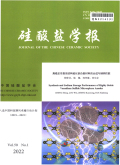硅酸盐学报2024,Vol.52Issue(7):2254-2263,10.DOI:10.14062/j.issn.0454-5648.20230964
共溶剂作用下锌沉积界面行为
Interfacial Behavior of Zinc Metal Anode Deposition Under Co-Solvent Condition
摘要
Abstract
Introduction Aqueous zinc-ion battery is considered as one of the most promising candidates for large-scale energy storage device due to its low cost,high safety and recyclability.Compared with other alkali-based batteries,zinc-based batteries can realize energy storage through 2-electron charge transfer delivering a high specific capacity(820 mA·h/g)and low price.However,the existing development of zinc-ion battery is far from commercialization.Main challenges exhibit in three aspects,i.e.,a serious dendrite effect caused by the uneven deposition of zinc ions in the battery;uncontrollable water-induced parasitic reactions such as hydrogen evolution reaction(HER)in acidic electrolyte;and metal corrosion and irreversible side reactions on surface of anode.These challenges result in a low coulombic efficiency,a shorten cycle life of battery and even serious security risks.In order to solve the shortcomings of zinc anode,some methods(i.e.,zinc anode structure modification,electrolyte optimization and artificial interface layer(SEI)construction)are developed.Among them,a tunning electrolyte is a directive method to avoid negative side reactions and inhibit the dendrite growth.Electrolyte modification can realize a long-cycle-life zinc anode and a high efficient battery.In this paper,tetraethylene glycol dimethyl ether(TEGDME)was added into ZnSO4 based electrolyte as s co-solvent to investigate the plating/stripping behavior of Zn metal.The reaction mechanism of co-solvation effect from multi-scale was analyzed. Methods All reagents with analytical purity were used without any treatment.For the preparation of bare electrolyte,2.87 g of ZnSO4·7H2O was dissolved into 10 mL distilled water to prepare 1 mol/L ZnSO4 electrolyte.For the preparation of co-solvent electrolyte,2.87 g of dried lithium bistrifluoromethyl sulfonate(LITFSI)was dissolved into 10 mL dehydrated tetraethylene glycol dimethyl ether(TEGDME)in an argon glove box under stirring for overnight.The final concentration was controlled to 1 mol/L LITFSI/TEGDME.A mixed electrolyte was prepared via dissolving 5 mL aqueous ZnSO4 electrolyte,3 mL of LITFSI/TEGDME electrolyte,and 2 mL of distilled water.The mixture was stirred at room temperature for 2 h,and then aged for 12 h to obtain the final electrolyte. The monitoring during charge/discharge process was carried out on a model EQCM-D instrument(AWS,A-20,Spain).In this experiment,a 12 mm diameter titanium-gold quartz wafer was used as a cathode,and a high purity zinc foil was used as an anode.The amount of electrolyte was 2 mL.Before the measurement,the cell was active at a low current density.Afterwards,the frequency and dissipation were recorded during the electrochemical process. The surface roughness was determined by ex-situ atomic force microscopy(AFM)(EIS)method,The impedance detection during electrochemical process was carried out by in-situ electrochemical impedance.The distribution of relaxation times(DRT)analysis was carried out based on the in-situ EIS results.The electrochemical performance was measured on 1470E electrochemical workstation.The surface conditions of the two electrodes were analyzed by X-ray diffraction. Result and discussion An electrolyte(Co-Solv)for aqueous zinc battery was designed via mixing aqueous electrolyte with TEGDME/LITFSI.The electrochemical measurement reveals that the Coulomb efficiencies(CE)of Co-Solv is 97.2%,which is higher than that of bare electrolyte based battery(i.e.,94.4%).The main reason is due to the co-solvent effect from water and TEGDME in Co-Solv electrolyte.This further confirmed by in-situ E-QCM results.Compared to the frequency and dissipation evolution during charge/discharge process,the surface electro-deposition process can be revealed.A rigid film with TEGDME/LITFSI can form on the top of anode,which further inhibits the occurrence of side reaction such as HER. Based on the results by AFM,the roughness in the bare electrolyte increases after electrochemical process.The roughness surface is closely related to the side reactions.The formation of irreversible basic zinc sulfate affects the anode performance.In the Co-Solv based battery,the roughness decreases and a rigid film appears on the top of anode to avoid the side reactions.This protected film is dense and firm to inhibit the formation of dendrite. According to the results from DRT analysis,the co-solvation effect can affect the double electric layer structure of the metal surface,and induce the uniform deposition of metal zinc via maintaining the stability of the local electric field on the electrode surface.Combined with the results by E-QCM and AFM,the addition of TEGDME/LITFSI can improve the electrochemical performance via inhibiting dendrite growth,reducing side reactions and blocking the HER. Conclusions TEGDME/LITFSI was a mixture adding into ZnSO4 based electrolyte to optimize the plating/stripping behavior of Zn metal.TEGDME could partly replace water to combine with Zn2+and form the co-solvent structure of Zn2+-TEGDME/H2O.It was indicated that the electrochemical reaction could related to the electric double layer structure near anode.Co-solvents could regulate the deposition of metallic zinc via affecting and stabilizing the local electric field.This work could provide a perspective potential for further development and mechanism analysis of co-solvent systems.关键词
金属锌负极/枝晶/共溶剂作用/原子力显微镜/电化学阻抗Key words
zinc metal anode/dendrite/co-solvent condition/atomic force microscope/electrochemical impedance分类
化学引用本文复制引用
许宏吉,高睿,胡灵龙,马静怡,冯明..共溶剂作用下锌沉积界面行为[J].硅酸盐学报,2024,52(7):2254-2263,10.基金项目
国家自然科学基金面上项目(52171210,21978110) (52171210,21978110)
吉林省重点研发计划(20220201130GX). (20220201130GX)

